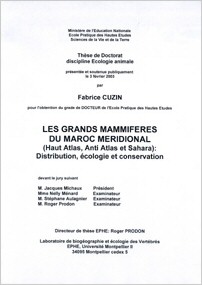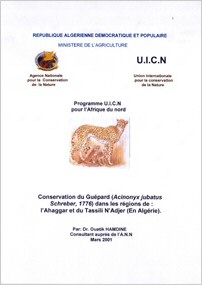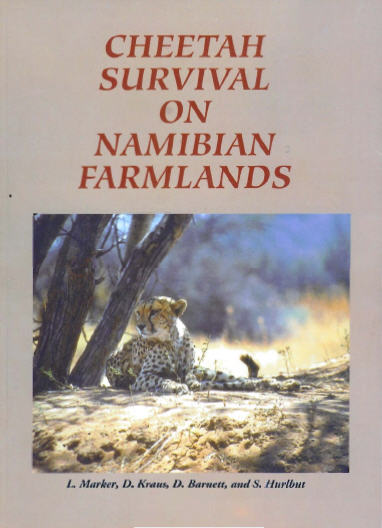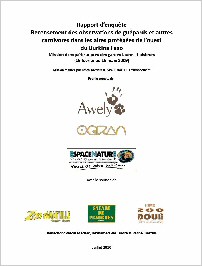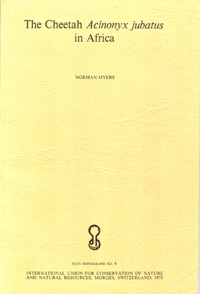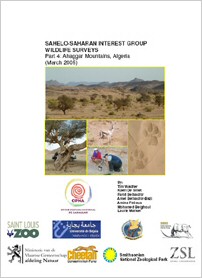|
Berry PSM. The cheetah in the Luangwa Valley. Black Lechwe, pp. 7-10 |
|
Currently, the only area in Zambia where cheetah occur in reasonable numbers is the Kafue National Park. A few may also exist in the Western Province, notably the Liuwa Plain National Park. The only other area likely to contain cheeah is the Luangwa Valley in eastern Zambia. The paper details cheetah sightings that have been reported from the Valley. |
|
Bertram B. 1984. Felids in East Africa. Proceedings of the Cat Specialist Group meeting in Kanha National Park, India, April 1984. p. 14. |
|
Cheetahs have been studied by McLaughlin in Nairobi, by Frame and Caro in Serengeti, and by Burney in Masai Mara. Although their total numbers in East Africa are believed to be fewer than 3,000 and declining, with rather poor prospects, the density recently found in bush country in northern Kenya gives hopes of a higher population than was otherwise thought. |
| Claro F. 2003. Survey of Fauna in Termit, Niger. In Monfort SL (ed).Fourth Annual Sahelo-Saharan Interest Group Meeting SSIG. 6 pp. |
|
This study of the fauna in the
Termit mountains area, Niger, mentions the observations of three cheetahs and
the recording of 20 signs of occurrence. According Toubou population, cheetah
occurs in the northern part of the Termit Mountains, from Gosso to Lolom. The
population is estimated at maybe fifty or so cheetahs in the Termit region. The
results of the ethno-zoological survey indicate that the cheetah is not very
present in the Toubou culture. The cheetah survival may depend on prey
abundance, in particular dorcas gazelles. Cette étude de la faune de la région du Termit au Niger mentionne l'observation de trois guépards et de 20 signes de présence. Selon la population Toubou, le guépard est présent dans la partie nord des montagnes du Termit allant de Gosso à Lolom. La population est estimée à une cinquantaine de guépard dans la région du Termit. D'après les résultats de l'enquête ethno-zoologique, le guépard n'est pas très présent dans la culture Toubou. La survie du guépard peut dépendre de l'abondance de ses proies, en particulier celle de la gazelle dorcas. |
|
|
Cuzin F. 2003. Les grands mammifères du Maroc méridonial (Haut Atlas, Anti Atlas et Sahara): Distribution, écologie et conservation (Large mammals of southern Morocco (High Atlas, Anti Atlas and Sahara): Distribution, ecology and conservation).
A study from bibliography and observational data (2181 observations including locality, altitude, climate and vegetation) was made on 29 species of large mammals (Primates, Carnivores, Ungulates, Hystrix cristata and Lepus capensis) that have been found in the 20th century in Morocco from the Atlas Mountains to the Sahara. For each species the distribution as a function of the geographic, altitudinal, climatic and vegetation variables, as well as the conservation status and the national IUCN (2001) status are given. The cheetah's population in Morocco seems not to exceed 20 individuals and is probably located along mined Saharan defence walls.
PhD, Laboratoire de biogéographie et écologie des Vertébrés, Ecole Pratique des Hautes Etudes, Université Montpellier II 347 pp. |
|
Farhadinia MS. 2007. Ecology and conservation of the Asiatic cheetah in Miandasht Wildlife Refuge, Iran. Iranian Cheetah Society; Report, 64 pp. |
|
Established in 1973, Minadasht Wildlife Refuge is the last verified cheetah habitat in Iran, which is located in northeastern country with more than 85000 hectares. The area has been one of the best ranges for the goitered gazelle before 1980s as well as the cheetah, but due to weakening of conservation actions since early 1980s, the area lost most of its gazelle population (more than 90%) and the cheetah was never seen. In winter 2002, the cheetah was reported from the area which drew the attention of the Iranian Cheetah Society (ICS) for more investigations in the area. |
|
Farhadinia_2007_Conservation_of_the_Asiatic_cheetah_in_Miandasht_WR_Iran.pdf |
|
Gros PM. Status of the Cheetah in eastern & southern Africa. Magazine article, 4-5. |
|
A two and a half years survey of cheetah's populations in southern Africa shows three principal trends: in relatively large countries, findings suggests a stability of the cheetah's status stable cheetah populations (Kenya, Tanzania, Botswana); in countries where cheetah distribution is limited to small patches, the species range shrank (Uganda, Malawi); and, in the last group of countries, conflicts between cheetahs and commercial ranches posed poses a serious threat on to the species survival (Namibia, Zimbabwe, South Africa). |
|
Gros PM. 1990. Global cheetah project Phase 1 - Cheetah status in southern Africa. Report 11 pp. |
|
The aim of the Global Cheetah Project is to assess the cheetah's status all over its range and to propose a plan for the conservation of the species, including technical solutions to be used. During the phase I of the project, five southern African countries have been surveyed, in a five months period: Malawi, Botswana, South Africa, Namibia and Zimbabwe. The survey has covered the geographical location of populations and their size, and the identification of the threats. The survey was done through a questionnaire. |
|
Gros PM. 1996. Status of the cheetah in Malawi. Nyala 19, 33-36. |
|
This study showed that, by 1989, the only resident cheetah population in Malawi occurred in Kasungu National Park. However, transient cheetahs, most likely coming from Zambia, occasionally visited Nyika National Park and Vwaza Marsh Wildlife Reserve. According to these results, it is critical for the long term survival of the species in Malawi to allow for cheetah movements between the three protected areas currently occupied or visited by cheetahs and the Luangwa Valley in Zambia. |
|
Gros PM. 1998. Status of the cheetah Acinonyx jubatus in Kenya: a field-interview assessment. Biol Conserv 85, 137-149. |
|
A field-interview survey of the distribution and abundance of the cheetah Acinonyx jubatus was conducted in Kenya between May and September 1989, and June and August 1990. Two hundred and twenty respondents ranging from wildlife conservationists to traditional pastoralists gave precise descriptions of cheetah observations, including dates and locations of sightings, and number, age class, and sex of the cheetahs observed. The 369 detailed sightings collected consisted of 249 observations of all-adult groups and 120 observations of family groups. The average number of adults in all-adult sightings was 1·8 + SE 0·07, and the average litter size in family groups was 2·6 + SE 0·10. Density estimates across the country ranged from 0·009 to 0·102 cheetah km-2, and were generally higher than elsewhere in Africa. A total number of 793 cheetahs was estimated in Kenya protected areas, and Masailand and the dry northern Districts appear to offer the best prospects for cheetah conservation in Kenya based on relative prey availability. The proportion of family groups among all sightings was twice as high in protected areas as on rangelands, and protected areas also held larger groups of males. The results do not support the thesis that cheetahs fare better on rangelands than in protected areas. Comparison with earlier surveys in Kenya showed remarkable stability in cheetah distribution and social structure over time. No firm conclusion could be drawn on trends in cheetah numbers, although scattered evidence supported a scenario of stability rather than decline in the last decades. Despite their limitations, interview based surveys can produce valuable results for monitoring elusive high-profile carnivores. |
|
Gros PM, Rejmanek M. 1999. Status and habitat preferences of Uganda cheetahs: an attempt to predict carnivore occurrence based on vegetation structure. Biodiversity and Conservation 8,1561-1583. |
|
In this paper we examine whether the occurrence of cheetahs (Acinonyx jubatus) in Uganda can be predicted from habitat characteristics extracted from a vegetation map. We first established the status of the cheetah in Uganda through field-interviews that Gros conducted in 1990. Cheetahs occurred almost exclusively in the Karamoja region where we estimated 53-310 individuals. Based on 216 sightings, the average number of adults in all-adults sightings was 1.65 + SD 0.95 and the average number of cubs in family groups 2.5 + SD 1.65. Compared to Graham and Parker's 1965 East African survey, average adult group size was slightly smaller in 1990 and large family groups were rarer. Comparison with Gros 1990 survey showed considerably lower cub-to-adult ratio and percent of observations with cubs in Uganda than in Kenya. A Geographic Information System (GIS) analysis of vegetation structure in areas where cheetahs were observed and in those where none were reported suggested that cheetahs might favor habitats with 25-50% woody cover and grasses of medium height (50-100 cm). A discriminant analysis correctly classified 72.1% of used habitats and 70.4% of no-report habitats. A logistic regression analysis improved the correct allocation of used habitats by 2.2%. Either the discriminant function or the logistic regression, which require only four easily obtainable vegetation characteristics, may help to pinpoint suitable cheetah habitats for conservation purposes. Our approach could be adapted for analyzing habitat suitability for other species of carnivores. |
|
Gros_&_Rejmanek_1999_Status_and_habitat_preferences_of_Uganda_cheetahs.pdf |
|
Gros PM. 2000. Status of the cheetah in Tanzania in the mid 1990's. Journal of East African Natural History 89, 85-100. |
|
This paper presents the results of a field interview survey and a literature review of the status of the cheetah (Acinonyx jubatus) in Tanzania. The survey was conducted between September 1993 and May 1994. The presence of cheetahs was documented in 30 areas (seven national parks, Ngorongoro Conservation Area, six game reserves, 13 game controlled areas, and 3 open areas), where a minimum of 366 cheetahs was estimated based on the sightings collected. In each of the 30 areas, cheetah status was evaluated in terms of distribution, frequency of observation, relative abundance, perceived trends in total numbers, and, where possible, minimum density estimates. The densities estimated, ranging from 1 cheetah per 40 km2 to 11925 km2, were lower than the average density in Africa. Estimators of abundance, frequency of observations, and trends tended to indicate a better cheetah status in the northern acacia savannas than in the southern miombo savannas. Family groups and large groups of adults where common in the north, while sightings of lone adults predominated in the south. Recommendations for the conservation of cheetahs in Tanzania include: starting a nationwide monitoring of populations using this study as a blueprint and its results as a baseline; maintaining spatial connections between currently established cheetah populations; and favouring semi-nomadic pastoralism over farming and intensive ranching on rangelands. |
|
Gros PM. 2002. The status and conservation of the cheetah Acinonyx jubatus in Tanzania. Biol Conserv 106, 177-185. |
|
This is the first assessment of the status of cheetahs, Acinonyx jubatus, in Tanzania since 1965. It completes a series of recent studies in Kenya, Uganda, and Malawi to provide an overall understanding of the species' status in East Africa. Interviews with 370 informants yielded 1050 cheetah sightings. Eighty nine percent of all sightings were made in 1990-1994, and 39% of all sightings occurred in protected areas. All-adult groups contained 1.92±0.04 S.D. individuals; the average number of dependent cubs was 2.63±0.08 S.D.; and the cub-to-adult ratio was 0.34. Since the 1960s, the distribution has remained stable overall with possible reductions in central Tanzania. No definite population trends were detected. With an estimated 569-1007 cheetahs, Tanzania emerges as a sanctuary for the species worldwide. However rangelands, which may hold half of Tanzania's cheetahs, are undergoing rapid degradation. This precarious situation calls for the establishment of a nationwide monitoring program. Distribution map and population sizes from this study could serve as a baseline for monitoring the species' status. |
|
Hamdine W, Meftah T, Sehki A. 2003. Répartition et statut du guépard (Acinonyx jubatus Schrebert, 1776) dans le Sahara central algérien (Ahaggar et Tassili). Mammalia 67(3):439-43. |
|
Recent data of the presence of the Cheetah (Acinonyx jubatus Schreber, 1776) in the central Sahara have allowed to actualize his geographical distribution. Nevertheless, the estimation of population numbers remains vague in the Ahaggar and Tassili n'Ajire's region. The current status of the species in Algeria (according to criteria of the IUCN, 1994) is evoked. A brief analyzes of factors of regressions and the problem of protection of the Cheetah is stated in this study. Although still present in the region, the author considered that the species was on the brink of extinction mainly because of the poaching pressure by local nomads (11 cheetahs officially killed between 1995 and 1998). Cet article, dans lequel un résumé en français est fourni, résume les données récemment collectées sur la présence du guépard dans les régions de l'Ahaggar et du Tassili N'Ajjer (Algérie). Le lecteur peut se référer au tableau joint pour prendre connaissance des observations de guépard. Bien qu'encore présent dans la région, l'auteur considère que l'espèce est au bord de l'extinction principalement en raison de la pression de braconnage exercée par les nomades (11 guépards ont été officiellement tués entre 1995 et 1998). |
|
Hamdine_et_al_2003_Status_and_distribution_of_the_cheetah_in_central_Algeria.pdf |
|
|
Hamdine, O. 2001 Conservation du Guépard (Acinonyx jubatus, Schreber 1776) dans les régions de: l'Ahaggar et du Tassili N'Adjer (en Algéie)
Conservation of the Cheetah in the region of l'Ahaggar and Tassili N'Adjer in Algeria
In the 19th century the cheetah inhabited probably all the Sahara, but today it has disappeared in numerous areas and is seriously menaced of disappearance. Recent observations report the cheetah in the Lassili N'Adjer and the Hoggar regions, where its presence seems actually very likely.
A.N.N. and IUCN 50 pp. |
|
Happold DCD. 2000. Nigerian Mammals. Nigerian Field 65(3/4):193-211. |
|
In this article about mammals in Nigeria, the cheetah is classified among the vulnerable species and of which the populations decline. Dans cette article sur les mammifères du Nigeria, le guépard est classé parmi les espèces vulnérables et dont les populations sont en déclin. |
|
Hoath R. 2003. Cheetah. In: Hoat R, editor. A Field guide to the Mammals of Egypt. Cairo: The American University in Cairo Press; p 104-105. |
|
After a brief description of the species, the cheetah is now extinct in the Middle East (including Arabia to Iran, Pakistan and India), except for a small population south of the Caspian Sea. It is almost certainly extinct in Arabia. It is very rare in Egypt, possibly extinct. It is restricted to the Western Desert in and around the Qattara Depression (tracks and skins evidence). Its current population is unknown but very low. The last records of specimen alive dated of 1993 and 1994. Après une brève description de l'espèce, le guépard est maintenant éteint au Moyen Orient (incluant l'Arabie à l'Iran, le Pakistan et l'Inde), sauf pour une petite population au sud de la Mer Caspienne. Il est fort probablement éteint en Arabie. Il est très rare en Egypte, vraisemblablement éteint. Il est restreint à l'ouest du désert dans et autour de la dépression de Qattara (empreintes et signes de présence). Sa population actuelle est inconnue mais très faible. Les dernières observations de spécimens vivants datent de 1993 et 1994. |
|
Hoat_2003_A_field_guide_to_mammals_of_Egypt_-_The_cheetah.pdf |
|
Hufnagel E. 1972. Cats (Felidae). In: Libyan mammals. The Oleander Press; p 41-44. |
|
The cheetah is very rare in Libya and the number of individuals is declining. 30 years of observational data (from 1932 to 1969) are resumed in this document. A map shows the localities of the observations. The cheetah was already so rare at that time that every sighting was an event and got a lot of attention. Some skull measurements of three skulls from Libya are presented. The skulls were given to the Museum of Natural History in Vienna. |
|
|
IFAW; Panthera; IUCN/SSC Canid Specialist Group; IUCN/SSC Cat Specialist Group; Wildlife Conservation Society. 2010.
The Fading call of the Wild - A status update on 15 species of disappearing wild cats & canids
|
|
Kraus D, Marker-Kraus L. 1991. The status of the cheetah (Acinonyx jubatus) 26 p. |
|
The status of the cheetah, Acinonyx jubatus, varies widely in the 44 countries listed in this report, being extinct in a few countries, nearly so in some, and endangered in most others. Only in two or three countries, the cheetah populations are considered only threatened, where they are legally eliminated if found to be in conflict with human interests. All populations are regulated by CITES in Appendix I, which regulates international trade. However, a few countries in the world have lifted the ban and have allowed import of hunting trophies. Namibia is exporting a limited number of wild caught animals for zoological and private facilities. |
|
Kraus D, Marker-Kraus L. 1992. Current status of the cheetah (Acinonyx jubatus) Washington, D.C.: NOAHS Center, National Zoological Park; 20 p. |
|
The status of the cheetah, Acinonyx jubatus, varies widely in the 44 countries listed in this report, being extinct in a few countries, nearly so in some, and endangered in most. Only in two or three countries are the cheetah populations such that they are considered only threatened, where they are legally eliminated if found to be in conflict with human interests. All populations are regulated by CITES as Appendix I, which bans international commerce and sporting trophies. Namibia has been exporting a limited number of wild caught animals for zoological and private exhibition. At the January 1992 CITES meeting, quotas were set for export of 150 animals from Namibia, 50 animals from Zimbabwe, and 5 animals from Botswana. Information on distribution and status in the different countries where cheetahs occur are presented. |
|
Laurent A, Laurent D. 2002. Guépard. In: Djibouti: les mammifères d'hier à aujourd'hui pour demain. p 175-177. |
|
Oral and written reports of cheetah observations collected from 1963 to 2001 in Djibouti are resumed in a map. Distribution in adjacent countries are also discussed. While the cheetah is likely to live in most regions of Djibouti, it is in danger of extinction. The species is considered as a luxury good in the country and is very attractive to occasional poachers. The export of trophies from some regions is very important, but confiscation and punishment measures have been recently introduced. Although not common in the 1980s, the cheetah remains widespread in the eastern and southern lowlands of Ethiopia, but it is threatened by illegal hunting and the destruction of the natural habitat by humans. According to a recent report (2002), the cheetah seems to be numerous in the west Mille district of the Afar region (Werdanso region). In the 1960s, cheetahs have suffered a very serious depletion in Somaila and disappeared from the more settled areas. More recent sightings report the cheetah in the Caluula, Skushuban and Qardho districts and in the Sidali region. |
|
Laurent_&_Laurent_2002_Djibouti_les_mammifères_d'hier_à_aujourd'hui_pour_demain.pdf |
|
|
Marker, L., Kraus, D., Barnett, D. and Hurlbut, S. 2003 (3rd edition): Cheetah survival on Namibia farmlands
The largest cheetah population in the wild is found in Namibia, primarily on commercial livestock farmlands, and is estimated at 2 000 to 3 000 animals. Therefore, it is critical to establish the status of Namibia 's cheetah population and determine the attitudes for its survival in the country. From 1991-1993, the Cheetah Conservation Fund (CCF) conducted an in-depth survey of Namibia's north central commercial farmlands.
Cheetha Conservation Fund (CCF) 99 pp. Marker_et_al_2003_Cheetah_survival_on_Namibian_farmlands.pdf |
||||||||||||
|
|||||||||||||
|
|
Myers N. 1975: The Cheetah Acinonyx jubatus in Africa For the purpose of obtaining a working figure for cheetah numbers, the report attempts a biome-by-biome estimate. At best, however, this can provide only a rough approxiamtion of totals. Subject to this qualification, it is calculated that in the whole region, the number may be slightly over 15'000, but of these two-thirds survive in savannah and subdesert zones south of 15°s.
IUCN Monographs, IUCN, Morges 90 pp. |
||||||||||||
|
|||||||||||||
|
|
Wacher,T.,
de Smet,K., Belbachir,F., Belbachir-Bazi,A., Fellous,A.,
Belghoul,M. and Marker,L. 2005.
This report summarizes results of a gazelle and cheetah survey of the central zone of the Ahaggar National Park, 7 - 23 March, 2005. The objective was to conduct a wildlife reconnaissance survey of little visited areas focusing simultaneously on distribution and relative abundance of cheetah and their prey base, particularly gazelles.
Wacher_et_al_2005_Wildlife_survey_in_the_central_Ahaggar_Mountains.pdf Wacher_et_al_2005_Wildlife_survey_in_the_central_Ahaggar_Mountains_French.pdf |
||||||||||||
|
|||||||||||||
|
|
|
||||||||||||
